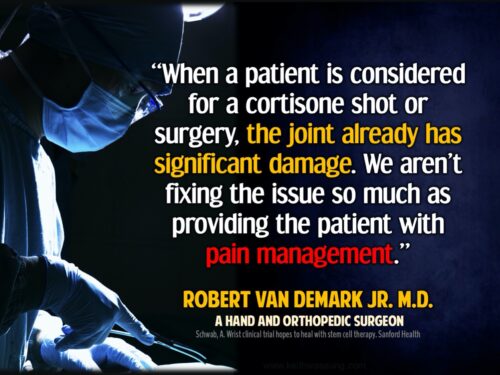Are you experiencing sciatica pain going down your leg? And did the pain begin years ago with aggravating pain in the gluts or the back of the thigh? Or are you noticing new symptoms of tingling down to the calf and toes? Sciatica pain and symptoms often occur with sitting, standing, and walking; and may be relieved with lying down. Does that sound like you?
Chiropractors should be the first physician to see about sciatica pain because this is an area they treat all of the time. But if the pain continues after giving chiropractic a chance (several or more treatments are usually needed), and then also trying other various treatment modalities, like acupuncture, massage, and physical therapy, the next step would be Regenerative Orthopedics as a solution for this persistent pain.
Did you receive an MRI with a report revealing some type of encroachment on a nerve root in the lower back area, which is pinching the nerve, and possibly some displacement and/or degeneration in the vertebrae of the lower back? These are common on MRI reports when experiencing sciatica pain. The displacement mentioned in the report may include forward or backward movement of the vertebrae. And this movement pinches the nerve root due to instability in the lumbar spine caused by ligament laxity.
Ligaments are a type of connective tissue that connects bone to bone. And ligaments help to stabilize the spine and other joints. Injured ligaments are often lax. When they become lax or loose, they have difficulty healing because they have a pretty poor blood supply.
Regenerative Orthopedics stimulates the body to boost the blood supply and fibroblasts in the injured areas, resulting in repair of the injured ligaments. The fibroblasts are the cells through which collagen is made and by which tendons and ligaments repair.
Regenerative Orthopedics helps strengthen and tighten the ligaments. This results in stabilization of the joints of the lumbar spine which then stops the pinching of the nerve.
A lumbar epidural is an injection into the epidural space of the lumbar spine. When patients experience referred pain, either cortisone (steroid) or dextrose injections can be used. Steroids are strong anti-inflammatories. But they need to be limited to no more than 3-4 injections each year in order to prevent the thinning of the bone and connective tissue damage.

A Problem with Cortisone Is That It Is Just a Bandaid Over Degeneration
At OrthoRegen®, we endeavor to build up the soft tissue and joint structures. Because of that, we do not use substances like cortisone, because it causes degeneration and inhibits healing. Instead, we use a dextrose solution to reduce the swelling of the nerve without the anti-inflammatory effect and the steroid side effects.
Regenerative Orthopedics eliminate or reduce pain, numbness, and tingling, enabling the former sciatica pain sufferer to be able to sit, stand, and walk without any pain or annoying symptoms. The treatment effectively resolves the symptoms and results in pain-free living.
Here at OrthoRegen®, we practice a comprehensive approach to Regenerative Orthopedics. And it’s a great alternative to surgery and joint replacement. The treatment helps regenerate connective soft tissues and accelerates recovery.
Lumbar instability results in an array of symptoms. And they include sacroiliac pain, lower back pain, sciatic pain, and referred leg pain. All of these symptoms can be treated effectively with Regenerative Orthopedics. So, if you are suffering from any of the symptoms listed above and would like to learn more, you can give us a call at (310)453-1234. We’d love to help you eliminate your sciatica symptoms.